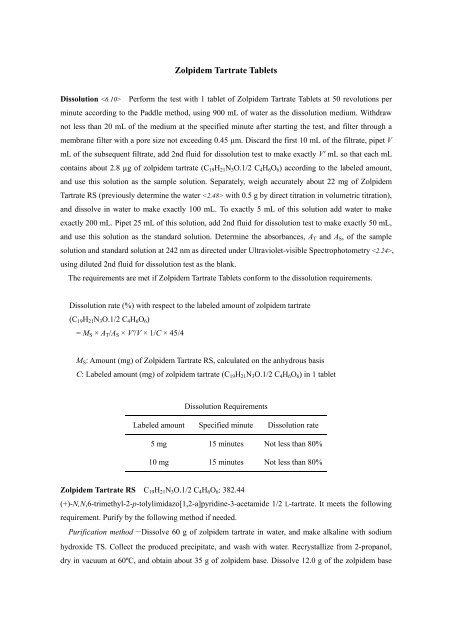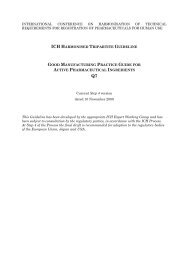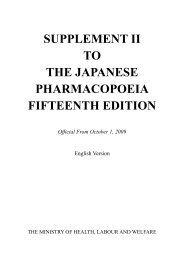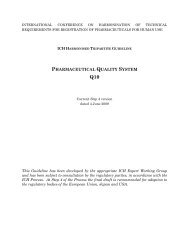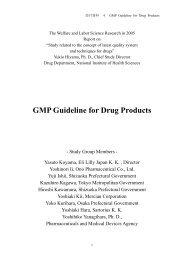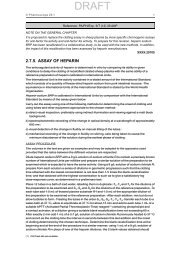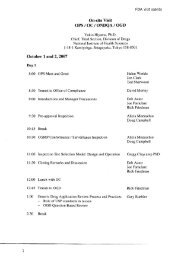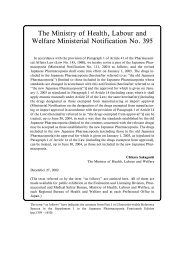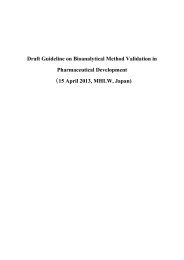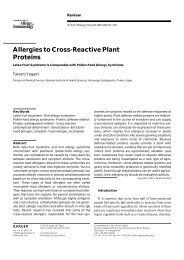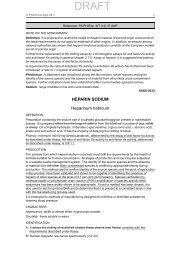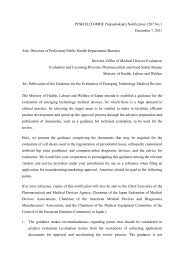Zolpidem Tartrate Tablets - NIHS
Zolpidem Tartrate Tablets - NIHS
Zolpidem Tartrate Tablets - NIHS
You also want an ePaper? Increase the reach of your titles
YUMPU automatically turns print PDFs into web optimized ePapers that Google loves.
<strong>Zolpidem</strong> <strong>Tartrate</strong> <strong>Tablets</strong><br />
Dissolution Perform the test with 1 tablet of <strong>Zolpidem</strong> <strong>Tartrate</strong> <strong>Tablets</strong> at 50 revolutions per<br />
minute according to the Paddle method, using 900 mL of water as the dissolution medium. Withdraw<br />
not less than 20 mL of the medium at the specified minute after starting the test, and filter through a<br />
membrane filter with a pore size not exceeding 0.45 µm. Discard the first 10 mL of the filtrate, pipet V<br />
mL of the subsequent filtrate, add 2nd fluid for dissolution test to make exactly V′ mL so that each mL<br />
contains about 2.8 µg of zolpidem tartrate (C19H21N3O.1/2 C4H6O6) according to the labeled amount,<br />
and use this solution as the sample solution. Separately, weigh accurately about 22 mg of <strong>Zolpidem</strong><br />
<strong>Tartrate</strong> RS (previously determine the water with 0.5 g by direct titration in volumetric titration),<br />
and dissolve in water to make exactly 100 mL. To exactly 5 mL of this solution add water to make<br />
exactly 200 mL. Pipet 25 mL of this solution, add 2nd fluid for dissolution test to make exactly 50 mL,<br />
and use this solution as the standard solution. Determine the absorbances, AT and AS, of the sample<br />
solution and standard solution at 242 nm as directed under Ultraviolet-visible Spectrophotometry ,<br />
using diluted 2nd fluid for dissolution test as the blank.<br />
The requirements are met if <strong>Zolpidem</strong> <strong>Tartrate</strong> <strong>Tablets</strong> conform to the dissolution requirements.<br />
Dissolution rate (%) with respect to the labeled amount of zolpidem tartrate<br />
(C19H21N3O.1/2 C4H6O6)<br />
= MS × AT/AS × V′/V × 1/C × 45/4<br />
MS: Amount (mg) of <strong>Zolpidem</strong> <strong>Tartrate</strong> RS, calculated on the anhydrous basis<br />
C: Labeled amount (mg) of zolpidem tartrate (C19H21N3O.1/2 C4H6O6) in 1 tablet<br />
Dissolution Requirements<br />
Labeled amount Specified minute Dissolution rate<br />
5 mg 15 minutes Not less than 80%<br />
10 mg 15 minutes Not less than 80%<br />
<strong>Zolpidem</strong> <strong>Tartrate</strong> RS C19H21N3O.1/2 C4H6O6: 382.44<br />
(+)-N,N,6-trimethyl-2-p-tolylimidazo[1,2-a]pyridine-3-acetamide 1/2 L-tartrate. It meets the following<br />
requirement. Purify by the following method if needed.<br />
Purification method-Dissolve 60 g of zolpidem tartrate in water, and make alkaline with sodium<br />
hydroxide TS. Collect the produced precipitate, and wash with water. Recrystallize from 2-propanol,<br />
dry in vacuum at 60ºC, and obtain about 35 g of zolpidem base. Dissolve 12.0 g of the zolpidem base
so obtained in methanol and add a solution prepared by dissolving 2.94 g of tartaric acid in methanol.<br />
After cooling, collect the produced precipitate, wash with methanol, dry in vacuum at 75ºC, and obtain<br />
about 12 g of <strong>Zolpidem</strong> <strong>Tartrate</strong> RS.<br />
Description-<strong>Zolpidem</strong> <strong>Tartrate</strong> RS occurs as a while crystalline powder.<br />
Optical rotation [α] 20<br />
D: about +1.8° (1 g, N,N-dimethylformamide, 20 mL, 100 mm).<br />
Identification:<br />
(1) Determine the infrared absorption spectrum of <strong>Zolpidem</strong> <strong>Tartrate</strong> RS as directed in the diffuse<br />
reflectance method under Infrared Spectrophotometry : it exhibits absorption at the wave<br />
numbers of about 3540 cm -1 , 3460 cm -1 , 1635 cm -1 , 1123 cm -1 , 853 cm -1 , 835 cm -1 and 797 cm -1 . To 1<br />
to 2 mg of <strong>Zolpidem</strong> <strong>Tartrate</strong> RS add 0.3 to 0.4 g of potassium bromide for infrared absorption<br />
spectrum.<br />
(2) Determine the spectrum of <strong>Zolpidem</strong> <strong>Tartrate</strong> RS in deuterated dimethylsulfoxide for nuclear<br />
magnetic resonance spectroscopy (1 in 25) as directed under Nuclear Magnetic Resonance<br />
Spectroscopy ( 13 C), using tetramethylsilane for nuclear magnetic resonance spectroscopy as a<br />
reference compound: it exhibits a signal at around δ28.8 ppm, δ35.2 ppm, δ36.9 ppm, δ72.0 ppm and<br />
δ120.7ppm.<br />
Related substances-Dissolve 10 mg of <strong>Zolpidem</strong> <strong>Tartrate</strong> RS in 20 mL of methanol, and use this<br />
solution as the sample solution. To exactly 1 mL of this solution add methanol to make exactly 100 mL.<br />
Pipet 2 mL of this solution, add methanol to make exactly 20 mL, and use this solution as the standard<br />
solution. Perform the test with 5 µL each of the sample solution and standard solution as directed under<br />
Liquid Chromatography according to the following conditions. Determine each peak area by the<br />
automatic integration method: the total area of the peaks other than zolpidem from the sample solution<br />
is not larger than the peak area of zolpidem from the standard solution.<br />
Operating conditions<br />
Detector: An ultraviolet absorption photometer (wavelength: 254 nm).<br />
Column: A stainless steel column 4.6 mm in inside diameter and 7.5 cm in length, packed with<br />
octadecylsilanized silica gel for liquid chromatography (5 μm in particle diameter).<br />
Column temperature: A constant temperature of about 25ºC.<br />
Mobile phase: To 4.9 g of phosphoric acid add 1000 mL of water, and adjust to pH 5.5 with<br />
triethylamine. To 550 mL of this solution add 250 mL of methanol and 200 mL of acetonitrile.<br />
Flow rate: Adjust the flow rate so that the retention time of zolpidem is about 5 minutes.<br />
Time span of measurement: About 5 times as long as the retention time of zolpidem beginning after<br />
the solvent peak.<br />
System suitability<br />
Test for required detectability: Dissolve 10 mg of <strong>Zolpidem</strong> <strong>Tartrate</strong> RS in 20 mL of methanol. Pipet<br />
1 mL of this solution, add methanol to make exactly 100 mL, and use this solution as the solution for<br />
system suitability test. To exactly 2 mL of this solution add methanol to make exactly 20 mL. Confirm
that the peak area of zolpidem obtained from 5 μL of this solution is equivalent to 7 to 13% of that<br />
from 5 μL of the solution for system suitability test.<br />
System performance: When the procedure is run with 5 µL of a solution, prepared by dissolving 10<br />
mg each of zolpidem tartrate and benzyl parahydroxybenzoate in 100 mL of methanol, under the above<br />
operating conditions, zolpidem and benzyl parahydroxybenzoate are eluted in this order with the<br />
resolution between these peaks being not less than 9.<br />
System repeatability: When the test is repeated 6 times with 5 μL of the standard solution under the<br />
above operating conditions, the relative standard deviation of the peak area of zolpidem is not more<br />
than 5.0%.<br />
Water : not more than 3.0%. (0.5g, volumetric titration, direct titration).<br />
Content: not less than 99.0%, calculated on the dehydrated basis. Assay-Weigh accurately about<br />
0.4 g of <strong>Zolpidem</strong> <strong>Tartrate</strong> RS, dissolve in 100 mL of a mixture of acetic anhydride and acetic acid<br />
(100), and titrate with 0.1 mol/L perchloric acid VS (potentiometric titration). Perform a blank<br />
determination in the same manner, and make any necessary correction.<br />
Each mL of 0.1 mol/L perchloric acid VS<br />
= 38.24 mg of C19H21N3O.1/2 C4H6O6


